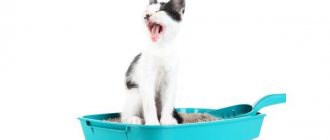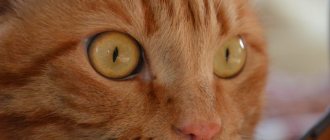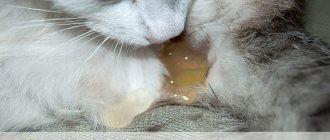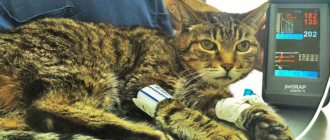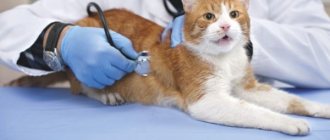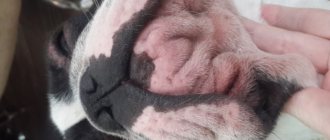In cats, spotting can be either normal or a sign of serious illness. In the first case, they accompany normal physiological processes, such as estrus or cleansing of the uterine cavity after childbirth. But if the discharge appears at the wrong time, causes discomfort to your pet and has a foul odor, you should consult a veterinarian as soon as possible. If this is not done, the animal may die.
So, how to distinguish normal discharge from pathological ones and how to treat a cat?
Risks of the condition
Regular or large amounts of blood loss can weaken even the strongest organism, which cannot cope with bleeding on its own without outside intervention. Severe blood loss in a cat can result in the following:
A single bleed in a cat is not dangerous.
- disruption of mechanical circulatory function;
- insufficient filling of blood vessels and cardiac compartments with blood;
- falling blood pressure;
- a sharp decrease in red blood cells and a drop in hemoglobin levels leads to the development of anemia;
- tissue hypoxia (oxygen starvation) due to a disrupted process of oxygen transfer through vessels to tissues and organs;
- disruption of local metabolic processes, which leads to massive cell death, and then the death of the organism.
This is interesting: Cat vomits undigested food
A cat has white uterine discharge: normal or pathological?
White genital discharge, if it is not associated with pregnancy or labor, is pus. Most often they occur due to decreased immunity as a result of the use of hormonal contraceptives or hormonal anti-inflammatory drugs.
Staphylococci are activated, which constantly live in the body and do not cause harm to health with a normally functioning immune system. Vaginitis develops.
Another cause of the disease is the consequences of mating with a cat infected with chlamydia, toxoplasma, feline immunodeficiency virus, and mycoplasma.
After a difficult birth, fragments of the placenta remain in the uterus, they fester, leading to endometritis. The most dangerous pathology that begins with white discharge is pyometra. The discharge becomes colored or stops. If additional symptoms appear - depression, pain in the enlarged abdomen, it means that pyometra has passed into the most dangerous - closed form. The pus does not come out, but accumulates inside the uterus.
In older animals, suppuration may be a symptom of a tumor process. The main reason for the occurrence of neoplasms is repeated hormonal disruptions caused by the termination of an unwanted pregnancy or the use of drugs to disrupt estrus.
First, a false pregnancy develops. The animal gets worried, begins to prepare the nest, and spoils the situation. She produces milk, but no kittens. Repeated imaginary tightness is dangerous because it triggers the process of development of neoplasms.
Be sure to read:
What to do if a cat has a dislocation: symptoms, diagnosis and treatment
Bloody discharge after pregnancy
If your cat has bloody discharge after pregnancy, this may indicate tissue rupture.
Often, specialists use hemostatic agents. Well, if the cat has lost a lot of blood, surgery may even be required.
Purulent-bloody discharge with a greenish tint may indicate inflammation of the cat’s genital organs. There are some prerequisites here:
- violation of sanitary standards;
- infection;
- internal diseases.
By the way, the cause may also be a fetus stuck in the cat’s womb. A process of decay occurs, causing the mother to become intoxicated. Of course, this could also be ordinary remnants of the placenta, the abundant release of which is not so terrible. Simple antibiotics will help here. However, in more severe cases, surgery will be required.
If you see drops of blood along with milk that come out as discharge from the genitals, then you can judge about inflammation of the mucous membrane.
A cat's body, which is weak after pregnancy, may not be able to cope with such a complication. However, with a calmer initial stage, the animal does not even need to be separated from its offspring.
Cat's appetite after surgery
If the cat was brought out of anesthesia by doctors and given to you under anesthesia, then the pet may show interest in food immediately upon arrival home. However, in some cases (this will depend on the type of surgery, suture and medications), the veterinarian recommends not feeding the animal for 24 hours after surgery. Ask your doctor about this.
If your cat has a poor appetite in the first days after surgery, this is also normal. There is no need to force her to eat: the main thing is to drink water. But if the cat refuses to eat for more than two days, you need to contact a veterinarian.
As for the quality of food, during this period it is very important that the cat’s stool is soft and without constipation. Otherwise, she will strain, which will cause pain due to the stitches. Therefore, almost all meat meals should include porridge: then the stool will be soft and there will be no need to strain.
In addition, it is very useful to give the cat fermented milk products during this period: kefir, fermented baked milk, yogurt, yogurt, but in no case milk - it makes cats swell, and excess gases from the operated abdominal cavity are not needed.
Overt and hidden internal bleeding
Discharge from a pregnant cat: bloody, yellow
It is impossible to see internal bleeding in a cat. But some similar processes are manifested by certain external symptoms and are called overt internal bleeding.
Table of external symptoms of obvious internal bleeding:
| Type of obvious internal bleeding | Accompanying external symptoms |
| Esophageal | Vomiting with bright scarlet blood. |
| Gastric | Burgundy or brown clots of coagulated blood in the vomit. |
| Intestinal | Burgundy or brown clots of coagulated blood in vomit (small intestine) and/or stool with traces of dark blood or black in consistency like coffee grounds (lower intestines). |
| Pulmonary | Wet cough with bloody foam. |
| Royal | Bloody discharge from the loop. |
| Renal | Blood or traces of it in every urine sample. |
External symptom of obvious internal bleeding
What does blood in cat feces look like and what does it indicate?
With various diseases, cat owners note the presence of bloody streaks, drops, and mucus in the stool. In these cases, the red tint of the stool immediately attracts attention. However, traces of bleeding cannot always be seen in feces with the naked eye. There are a number of diseases in which the stool contains occult blood. It can only be detected through stool analysis.
Scarlet drops, veins and the like
Scarlet clots, lumps of pink mucus, and blood puddles around formed feces are signs of the presence of obvious, undigested blood. They appear in diseases of the lower intestines. The bright scarlet color of impurities in feces that appear at the end of defecation indicates pathologies of the colon or rectum, or injuries to the anus.
Such symptoms may occur due to the consumption of low-quality food. Intestinal injury often occurs as a result of eating bones. Sometimes cats swallow foreign bodies while playing. Small plastic objects and pebbles come out undigested, scratch the intestinal walls and damage the mucous membranes.
There is blood, but it is not visible
The presence of blood in feces is not always noticeable. Damage to the upper gastrointestinal tract with bleeding is manifested by occult blood. The only sign of internal bleeding in the stomach, small intestine or duodenum is black stool. In this case, feces have a specific smell.
To establish the presence of hidden blood in the stool, you need to do a coprogram. This is an analysis that allows you to evaluate the enzymatic activity of the digestive glands, the type of predominant microflora, and determine the presence of parasites and hidden blood in the intestines.
Bloody discharge due to urolithiasis
Urolithiasis (urolithiasis) is a disease accompanied by the formation and deposition of urinary stones or sand in the organs of the urinary system.
Most often, the development of urolithiasis is provoked by an unbalanced diet, when the animal is fed too salty or fatty foods, table scraps, or the pet is kept exclusively on dry food.
Urolithiasis can progress very quickly and often leads to the death of the animal , so if a problem is detected, you should never self-medicate. To minimize your pet's suffering before visiting the veterinarian, you can give him Baralgin M (solution). Dosage: 0.05 mg per 1 kg of animal body weight.
Baralgin M is contraindicated for use if the pet is less than six months old.
Signs of ICD
The development of the disease is indicated by the following symptoms:
- presence of blood in the urine;
- restless behavior of the animal;
- lack of appetite;
- frequent urge to urinate, accompanied by a plaintive meow;
- small amount of urine when urinating;
- apathy.
If you suspect urolithiasis, you should immediately contact a veterinarian. Surgery may be required.
Prevention
As a preventive measure, it is recommended to adjust the animal’s diet. There are some general rules that must be followed when organizing a cat's diet :
- It is necessary to minimize the share of dry industrial food of economy class, because they contain a large amount of salt, which provokes the development of urolithiasis.
- It is recommended to exclude fatty natural products from the diet, including table food.
- Food should contain a minimum amount of sugar, salt, phosphorus and magnesium.
- Your cat should always have fresh water freely available.
The risk of developing the disease can also be reduced by encouraging an active pet lifestyle.
Can a cat run after surgery without wearing a blanket?
After laparoscopy (when not a large suture is made, but small incisions), it is not necessary to wear a blanket: only small stitch holes are visible on the cat. After a laparotomy (when there is a large incision), a blanket must be put on the cat. After removal of the testicles, cats do not wear anything. She will walk in this blanket for 10-14 days.
The good thing about a blanket is that it restricts the cat’s movements and prevents it from running and jumping too much, if suddenly under painkillers it seemed that it was healthy. Although, as practice shows, when jumping, even high ones, the seams do not come apart if they are made well. The main purpose of the blanket is to prevent the cat from getting to the seam and pulling out the threads, and also from licking the seam.
Many owners feel sorry for the cat, saying that the blanket interferes with her life. And on the fifth or sixth day after the operation, it seems that the blanket is no longer needed, because the cat is already active and behaves as if nothing had happened. As a result, some owners decide to remove the blanket or replace it with a sleeve from an old sweater, in which holes are made for paws. Under no circumstances should you do this! The blanket, we repeat, is needed not to hold the seam, but to protect it from the cat’s interference. As soon as the blanket is removed from the cat, she begins to work on the suture in earnest and most often ends up on the operating table again. Only this time the stitch won’t be able to heal so easily: now the cat will have to wear a blanket for 2 months. Do you need this for the sake of false momentary pity that the cat is uncomfortable?
Tested by the experience of hundreds of cat owners: the blanket remains on the cat for 10-14 days without any problems and is never removed. That is, if you have not been prescribed seam treatment, you should not touch the blanket at all.
This is what a cat looks like in its butt
Hematuria: causes and first aid
If a cat is bleeding from the urethra, this may indicate the presence of serious pathologies in the pet’s body that will require long-term treatment and rehabilitation.
First you need to find out the reason for its appearance. This can be done by collecting the animal’s urine for analysis and, first of all, confirming the presence of red blood cells in it.
How to do it correctly:
- The tray where the cat goes to the toilet should be thoroughly washed with hot water. There is no need to use any household chemicals, since it is quite difficult to rinse them out, and when mixed with the sample for analysis, it will spoil the indicators and prevent the picture of the disease from being correctly interpreted.
- The filler should be removed from the tray; the maximum that can be used is sea pebbles, also carefully washed with ordinary running water.
- The collected sample is transferred to a sterile container and taken to the veterinary laboratory. This should happen no more than 4 hours after collection.
- The animal's last meal should be 6 hours before the test, so as not to blur the true picture.
This is interesting: What to do if a cat has mammary cancer?
Constipation after surgery
Despite proper nutrition, your cat may experience constipation for 2-4 days after surgery. Make sure your pet goes to the toilet at least once every 2 days. If you see that the second day is already ending and the tray is empty, it is better to give your pet Vaseline oil: pour it into the mouth through a syringe at the rate of 5 ml per 5 kg of weight. It is absolutely harmless, but it helps to go to the toilet. The effect must be achieved by giving Vaseline every 8 hours until the cat poops.
It happens that the cat refuses to write. In this case, it is recommended to administer a Microlax microenema for children, which immediately causes both urination and defecation. The microenemas should be injected into the butt; under no circumstances should the medicine be given into the mouth.
In addition, feline lactobacilli can be added to your cat's food, which will help cope with dysbiosis caused by antibiotics.
Pink discharge that is not dangerous
Discharge in the first period of a pale pink color is most often associated with the release of unfertilized eggs to the outside.
If such bleeding does not intensify and does not have a foreign odor, then there is no need to worry.
In the second period, there should normally be no bleeding. During this period, babies are actively gaining growth, the uterus is expanding, and the animal’s tummy is noticeably rounded. If there is noticeable scarlet bleeding that lasts more than 10 minutes, you should immediately consult a doctor. Possible causes: uterine rupture, inflammation, miscarriage.
We invite you to familiarize yourself with Sweets for cats - 95 photos of permitted and prohibited food products for cats
In the third period at the end of pregnancy, a small bloody discharge (blood volume maximum 1 tablespoon) can serve as a harbinger of the onset of labor.
Cats are very clean by nature, so if your pet feels good, is cheerful and cheerful, then she licks herself on her own and the owner does not have time to notice anything. The presence of sticky lumps of mucus around the animal's loop should alert you. This is a sign that the pet is unwell and needs urgent help from the owner.
Painkillers
A neutered cat may experience pain in the first couple of days, so pain medication should be given. Aggressiveness, refusal to eat, dilated pupils, immobility - these are just a few signs that your pet is in pain. You can help the animal by giving analgesics:
- Previcox;
- Ainil;
- Loxicom;
- Ketoprofen.
There are other medications, give your cat whatever the vet says. Very rarely, animals are given No-Shpu and Analgin, and Paracetamol is simply dangerous for the pet’s life
. The dose must be prescribed by the veterinarian who performed the operation.
Those who do not know how or are afraid to give an injection need to take a partial dose of painkiller orally. When an hour has passed, you can already process the seam.
Pyometra
Among the most common diseases of cats with bloody discharge is pyometra, a form of purulent endometritis in which pus accumulates in the uterine cavity. The disease is most often provoked by rash actions of the owners themselves, namely:
- abuse of hormonal drugs during estrus;
- uncontrolled mating;
- infection in the vagina during childbirth.
There are two types of pyometra:
- Open form - blood clots come out of the vagina. The cat licks itself frequently, approximately every 15-20 minutes. The animal's temperature rises, the cat often drinks water.
- Closed form - no discharge visible, because blood accumulates in the uterine cavity. Symptoms of the closed form of pyometra: enlarged, tight abdomen, frequent urination, apathy, rapid breathing.
Of these two forms, the second poses the greatest threat to health, because. excessive accumulation of pus in the uterus can lead to the death of the animal.
Discharge in a pregnant cat as a symptom
Before and after birth, cat owners may notice discharge of one color or another volume from their pet. There are situations when there is no need to worry; such physiological processes are characteristic of a female during the period of bearing offspring.
But, unfortunately, it is not uncommon for discharges that are serious symptoms of diseases and dangerous health conditions of the cat. One of the most dangerous symptoms is scarlet bloody discharge.
- The liquid, which appears as scarlet blood with or without mucus, indicates the presence of dangerous bleeding in a pregnant animal. The allocation lasts about 10 minutes, you can’t waste time and wait for it to end. You need to immediately take your pet to a doctor who can stop the bleeding.
- If a brown discharge appears in the second stage of pregnancy, it indicates placental abruption. When such liquid comes out, it is dangerous for both the cat and her baby.
- Why does green discharge appear with an unpleasant and rather strong smell of decaying flesh? They will appear in the event of fetal death. This is one of the most dangerous situations in the pregnancy of an animal, since intoxication of the entire body occurs due to the death of the unborn kitten. Different systems can fail, the kidneys react especially quickly.
- There may be discharge with pus; they indicate the presence of an inflammatory process in the body. The cat should also be examined by a specialist and urgent treatment prescribed. Effective antibiotics and other drugs can be used to save a pet. Sometimes only termination of pregnancy can help.
Usually the bleeding is due to a rupture of the uterus or its tissues, but there may be other problems. Red discharge indicates problems not only in the birth system, but also in other organs.
What measures do veterinarians take in case of detachment? The cat is thoroughly examined in a veterinary clinic, she undergoes an ultrasound, and undergoes comprehensive tests. Then, until birth, the animal must be monitored.
Pregnancy can be resolved more successfully if safety measures are taken. The doctor will also check to see if there are any dead kittens in the cat's stomach; if there are any, he may suggest a cesarean section or premature birth to save the cat.
Owners sometimes confuse diarrhea with discharge from the reproductive system. But even such a health situation must be resolved quickly and competently. After all, a disorder of the digestive system can also affect pregnancy.
When the fetus comes out, you should also look at the appearance of amniotic fluid and other characteristic discharge. If the cat gave birth at home, you need to tell the veterinarian what kind of discharge there was, in terms of color, structure, and quantity. He may prescribe medications to restore the health of the giving birth animal.
We invite you to read: Antihistamines for cats: a brief overview
Scarlet blood is always a very bad sign; if a pregnant cat's bleeding is light in color, lasts more than 10 minutes, its total volume is more than two tablespoons - this is full-fledged bleeding, which requires immediate relief, otherwise death. The most common cause of bleeding is uterine tissue rupture.
Brown discharge in the middle stage of pregnancy is a symptom of placental abruption or the death of kittens. When placental abruption occurs at 8–9 weeks, no “drastic” measures are taken; the cat is monitored, ultrasounds and tests are done, trends are monitored and the birth is expected - at least in this case, the cat has a greater chance of survival.
Green discharge with a pungent odor is a clear, almost guaranteed sign of the death of one or more fruits and the beginning of the decomposition process. A very dangerous situation, the cat’s body suffers from internal intoxication and gradual kidney failure. The situation can only be resolved surgically or by inducing labor, after which the cat is prescribed intensive rehabilitation therapy.
Purulent discharge, even in small quantities, indicates inflammation. The pet needs examination, consultation with a veterinarian and urgent treatment. Depending on the results of blood tests, gestational age and ultrasound readings, treatment with antibiotics or termination of pregnancy with subsequent therapy is prescribed.
The cat's paw is swollen after surgery
In order to inject various drugs into the cat's blood, veterinarians place catheters on her paws. Through them, in particular, premedication and anesthesia are administered. Sometimes the catheter is not removed immediately after the operation, but is done the next day, so that if something happens, the animal can quickly inject the necessary drug directly into the blood.
After the catheter is removed, you will notice that the cat's paw is swollen. This is a reaction to the dressing that holds the catheter in place. After a few hours, the swelling should go away. If it persists for more than a day, consult a doctor.
This is what a catheter looks like on a cat and a paw after the catheter
Why does a cat bleed from the anus: diagnosis and treatment
A specialist can diagnose internal bleeding in a cat using the following diagnostic methods:
- external examination and palpation;
- Ultrasound, x-ray of the abdominal organs;
- uterine smear cytology;
- histology of biopsy material;
- biochemical, general and blood clotting tests;
- Analysis of urine;
- vaginoscopy;
- bac sowing
Ultrasound of the cat's abdomen
Based on the results of the study, the doctor prescribes the necessary treatment:
- antibiotics to prevent infections and inflammatory processes in combination with probiotics;
- surgery in case of detection of oncology, endometritis;
- chemotherapy to exclude relapse after surgery;
- blood transfusion in case of significant blood loss;
- antishock therapy;
- drugs to restore blood clotting.
Important! It is strongly recommended to adhere to the treatment prescribed by your veterinarian at home, this applies to the regimen, duration of administration and dosage of medications. After completing the course of treatment, you need to go to the clinic once a month for prevention.
Thus, bleeding in a pet is the most risky symptom of many terrible ailments. If you suspect such a condition, you should immediately seek help from a veterinarian.
Diagnosis and treatment
Vaginal bleeding in cats is always dangerous to health. If you do not stop it in time, the cat may die.
The veterinarian uses the following diagnostic methods to make an accurate diagnosis::
- general examination, palpation;
- Ultrasound of the abdominal organs, abdominal radiograph;
- cytology of discharge from the uterus;
- histological examination of biopsy material;
- vaginoscopy;
- urine and blood tests (general, biochemical, coagulability);
- sowing on nutrient media.
Depending on the cat's test results, the type of treatment prescribed will depend. It includes :
- Therapy with antibiotics for infectious diseases and inflammatory processes;
- Surgical intervention for oncology and endometritis;
- For major bleeding, a blood transfusion is given;
- Antishock therapy;
- Corrective therapy for bleeding disorders;
- Chemotherapy to reduce the risk of relapse after surgery.
Only a veterinarian prescribes treatment and selects the necessary medications. Their use must strictly correspond to their intended purpose. Self-medication leads to irreversible consequences. After a successful course, preventive examinations are recommended once a month.
Bloody discharge in cats is always a cause for concern. They may be a sign of a natural process or a serious illness. Why does a cat bleed from the anus and what to do in such situations? Let's look at a serious issue that every owner of a four-legged friend may face.
Normal changes that occur in the body
In some cases, bloody discharge is observed in a cat for reasons related to natural processes. Such circumstances do not pose a threat to the health of the animal. Such changes include the following:
- Estrus. This process is accompanied by an increase in the pet’s activity. The female often arches her back, rolls around on the floor, and becomes playful. It is absolutely normal for a cat to have bloody discharge during estrus. After this period ends (as a rule, this happens after a few days), the symptom disappears completely.
- Bearing offspring. The presence of this sign in a pregnant female indicates a restructuring of the body and preparation for the birth of cubs. However, intense discharge indicates the development of serious pathological processes.
Discharge from endometritis
This disease can have both an acute and chronic course. The second form of the disease does not affect the pet’s well-being. The cat mates with males, but in most cases pregnancy does not occur. If fertilization does occur, the cubs often die in the womb or almost immediately after birth. An acute inflammatory process in the inner mucous membrane of the uterus is a serious illness. Bloody discharge in cats with this pathology is accompanied by loss of appetite and general weakness. If you do not provide medical assistance to the animal in time, it may die.
Uterine bleeding in a cat
If your cat is bleeding from the uterus, there may be several reasons for this:
- Injuries and mechanical damage;
- Neoplasms, including malignant ones, in the uterus;
- Inflammatory processes of various etiologies;
- Delay of placenta during the birth process;
- Hormonal imbalance;
If the bleeding is not profuse, but consists of a few drops, then the cat immediately licks them off, leaving no trace. If it is quite strong, then the blood can flow in a small stream, leaving marks or puddles in the places where the cat lays down to rest.
Bleeding may not be accompanied by any visible changes in the condition or behavior of the mustachioed creature, or it may be accompanied by convulsive efforts if the placenta is delayed during the birth process. If a large amount of blood has been lost, the cat’s behavior will be characterized by lethargy, lack of appetite, but strong thirst.
When a cat is bleeding from the uterus, you can give it warmed milk or broth. It is advisable to call a veterinarian at home or transport the animal to a veterinary clinic for examination and diagnosis.
You can help your pet yourself by applying a towel soaked in cold water or an ice compress to the lower part of the peritoneum. These manipulations should help stop bleeding as quickly as possible.
Depending on the extent of damage to the animal's genitals, stitches and antibiotic therapy may be necessary.
Timely provision of first aid can save your pet’s life and save her from inflammation and the formation of abscesses.
However, we should not forget that self-treatment can have the opposite effect. Therefore, having provided primary support to a small creature, it is necessary to show it to a professional as soon as possible.
I graduated from the National State Agricultural Academy and have been working as a veterinarian for 8 years.
In my free time, I write articles about the diagnosis and treatment of cats.
Cat bleeding from anus
Abnormal discharge may also begin from the anus. This happens to animals of both sexes. They can be seen in the tray (after the pet has emptied), on the tail, in places where the cat usually sleeps. Reasons why a cat bleeds from the anus:
- Gastrointestinal diseases. There are many diseases of the digestive system that cause
inflammation and bleeding in the intestines. Blood is observed not only under the tail, but also in the feces. Impurities of pus and an unpleasant odor may appear. - Cracks in the rectum or anus. If your cat suffers from constipation, he may develop fissures or even hemorrhoids. The anus area will be red and swollen.
- Oncology. Animals get cancer too. Malignant tumors cause pain and bleeding.
- Urolithiasis disease. More often observed in older animals. Blood mixes with urine. After each bowel movement, red spots remain in the tray. There are also leaks under the tail, staining the anus. In such cases, it is difficult to understand where exactly the discharge is coming from. The disease sometimes alternates between periods of exacerbation and remission.
- Injuries. A cat can damage the anus area in games or unsuccessful jumps. If he goes outside, he gets into fights. In such situations, abrasions, scratches, and bruises may be observed under the tail.
From the eyes
The discharge of reddish-brown clots from the animal's eyes indicates an ophthalmic disease. There are a number of side signs that can be used to determine that a cat is sick:
- eye rubbing;
- depressed behavior;
- lack of appetite.
A possible cause of the pathology may be a violation of the patency of the lacrimal canals due to a foreign object or tumor entering the eye. In this case, an examination by an ophthalmologist is necessary.
Bloody discharge from the eyes in cats can also be caused by heat or sunburn . In this case, before providing professional assistance, you can drip the animal’s eyes with a solution of sodium sulfacyl, after rinsing them for 5-10 minutes.
Causes of bleeding in cats
A cat has a nosebleed: causes and diagnosis
There are many reasons explaining this condition.
Pyometra
In cats, bleeding from the vagina is a frequent companion to a disease such as pyometra. The development of this disease is most often provoked by an excess amount of progesterone in the cat’s body, which is produced in the following cases:
- uncontrolled use of hormonal contraceptives to prevent pregnancy;
- poor hygiene during estrus;
- violation of sanitary standards during childbirth;
- uncontrolled matings;
- impaired immunity, congenital hormonal changes;
- lack of physical activity.
Those at risk most often are elderly, nulliparous, pregnant cats with pathologies, including those who gave birth prematurely.
A cat with pyometra suffers a lot of pain
Endometritis
Endometritis is an inflammation of the walls of the uterus, often accompanied by a purulent process that further damages the organ, which provokes uterine bleeding. The greatest danger is the development of the disease in the postpartum period, when the uterine tissue has not yet recovered, and the slightest damage leads to copious bloody discharge from the cat’s uterus.
Note! It is recommended to sterilize the young female to prevent the development of endometritis and pyometra.
Bleeding disorder
Bleeding disorders in cats can be present from birth or develop later in life. Defects in the protein responsible for coagulation provoke prolonged blood flow and the formation of hematomas in the deep layers of tissue. Platelet defects result in frequent superficial bruising, nosebleeds, black, pasty stools when the intestines are damaged, and difficulty stopping blood after injections or surgery.
One of the symptoms of a bleeding disorder is that the blood does not stop well when the ear is damaged.
Congenital bleeding disorders include hemophilia type A, B, von Willebrand disease, Chediak-Higashi syndrome, Ehlers-Danloos syndrome, known as cutaneous asthenia.
For your information! The clotting process can be disrupted by pet poisoning with rat poison, weakened immunity and infectious diseases such as viral leukemia, infectious peritonitis, feline distemper or toxoplasmosis, as well as chronic diseases of internal organs.
What to do if your cat is bleeding
A pet with bleeding requires an urgent professional examination, which will establish the correct diagnosis and prescribe the necessary treatment. Attempts to stop prolonged or heavy blood loss using folk remedies can lead to the death of the cat. This is especially true in cases of bleeding in a kitten, since there is little blood in its body, and the loss of even the smallest dose can provoke the death of the baby.
Did your cat fall out of a window, get hit by a car, or become a victim of a beating? It is highly recommended that you visit a veterinarian, even if there are no visible injuries and your pet appears normal. Internal bleeding that does not open immediately after an injury can appear at any time due to a burst hematoma or a purulent process. It is recommended to carefully move the injured animal into a box with a hard bottom in order to eliminate complications from a possible spinal fracture.
Professional veterinary care
A cold compress is applied to the suspected bleeding site. If possible, the mouth and airways are carefully cleared of blood or vomit. It is strictly forbidden to feed or water an injured cat. If your pet loses consciousness, it is not recommended to stir, trying to bring him back to his senses, as such actions can aggravate the condition.
Note! If a cat is bleeding profusely from the uterus, you can give it water or warm broth and urgently visit a veterinarian or call him at home.
Reasons for appearance
If you notice blood from the cat’s vagina, you should not hesitate, hoping for an independent cure for the pathology. As a rule, bleeding from the genital organs of an animal is associated with pathological changes. Common causes of bloody discharge from the loop are:
- Inflammatory processes - endometritis and pyometra, as well as other pathologies of the reproductive system characterized by inflammation. Pathological changes in the endometrium lead to anxiety in the animal, accompanied by aggression and constant licking of the genitals.
- Violation of the integrity of the walls of the uterus. The reproductive organ in cats has a special structure - in the form of horns. The walls of the uterus are unusually supplied with blood, and with even minor damage, severe bleeding is observed, affecting the condition of the animal. Providing assistance in these cases must be immediate, since in a short period of time the animal can simply bleed to death.
- Malignant neoplasms in the genital organs. Oncology of internal organs does not make itself felt for a long time, but with the growth of a cancerous tumor, irreversible degenerative processes begin in healthy cells of the body. With cancer of the uterus, ovaries or other structures of the reproductive system in cats, discharge with blood and pus is observed, characterized by an unpleasant odor, which is associated with the growth and subsequent destruction of tumor cells.
- Unseparated placenta or placenta. After giving birth to a cat, it is recommended to visit a veterinary clinic and conduct an ultrasound examination of the reproductive organs. This is due to the fact that parts of the placenta can remain inside, rotting and causing inflammation. As a result of the placenta decomposing inside the uterus, purulent vaginal discharge mixed with blood appears. As a rule, treatment involves abdominal surgery followed by removal of the uterus.
- Blood after sterilization . Sterilization of a cat is carried out not only to stop the production of offspring, but also to prevent sexual heat in cats. Often, cat owners decide to undergo surgery in the clinic in order to prevent dangerous diseases of the reproductive system in cats (endometritis, ovarian cancer, pyometra). In some cases, with neoplasms in the area of the adrenal glands or milk bags, blood may be released from the vagina. If hysterotomy (removal of the uterus) was not performed during surgery, the appearance of cystic neoplasms in the uterine cavity can also cause bloody discharge in the operated animal. The causes of bleeding in a sterilized animal may also be associated with the presence of germ cells in other organs of the animal. This pathological phenomenon is rarely diagnosed, but in some cases it still happens.
How is the operation performed?
Not everyone decides to care for their pet on their own after surgery. Many people simply leave their pet in a hospital under the supervision of specialists. Such rehabilitation requires additional costs, but it is more reliable than rehabilitation at home.
You can only leave your animal in the care of a veterinarian whom you completely trust. This becomes especially important in winter, when it is too cold and dangerous to take your pet home.
Please note that recovery in a clinic, in an unfamiliar environment, is stressful for the animal. If your pet is a very timid person, it is hardly worth leaving her alone in an unfamiliar clinic. It’s better to pick her up and treat the cat’s suture yourself after sterilization.
Treatment
Before starting to treat the animal, the doctor finds out the root cause of the discharge. This will require the following examinations:
- initial examination of the animal, careful palpation of the abdominal area;
- general and biochemical blood test, laboratory urine test;
- Ultrasound of internal organs;
- examination of the uterus using a colposcope;
- study of secretions;
- bacterial culture to identify the pathogen;
- biopsy of the mucous membranes of the genital organs.
Based on the research results, the doctor makes a diagnosis and prescribes the necessary medications and procedures.
Depending on the reason for the bleeding, the cat is prescribed the following treatment:
- Anti-shock therapy is carried out using painkillers.
- If your cat is bleeding heavily, a blood transfusion may be required.
- If the bleeding is caused by low blood clotting, then corrective therapy is prescribed.
- For pathologies such as tumors or endometritis, surgery followed by chemotherapy is indicated to reduce the risk of relapse.
- The animal is prescribed antibiotics when the disease is caused by pathogenic microorganisms.
All medications and their dosage can be prescribed and adjusted only by a veterinarian. Self-medication will not only not bring a positive result, but can also lead to the premature death of your pet.
Seam processing
After the operation, the owner must monitor and care for the animal, observing the requirements:
- The cat must have a collar on, otherwise it may bite. In addition to the collar, be sure to wear a blanket for a week to 10 days. It should be used depending on how long it takes for the seams to grow together;
- An increase in temperature may occur. If it is below 39 and a half degrees, there is no need to worry. If it is higher, and, in addition, lasts for several days, you need to consult a doctor;
- After the operation, ichor or a little blood may ooze from the suture. This is normal, but if there is a lot of blood, you should immediately contact a veterinarian. The stitch may swell, turn red, and bruises may collect around it.
After four days you need to check the seam. If it is dry, then everything is healing normally, wet edges should be treated with antibacterial ointment. It may not be perfectly smooth, since the skin will heal only after the threads are removed.
On the second day, the seam should be wiped with a solution of chlorhexidine or miramistin, first cleaning it from hair. The use of brilliant green is undesirable. You can lubricate the seam and skin with Levomekol, carefully coating the skin and folds.
It is best to process the seam together: one person puts the cat on its hind legs, the other removes the blanket and processes the seam. Treatment of sutures after sterilization of a cat lasts from a week to ten days.
There is no need to take antibiotics if the operation took place under sterile conditions; they are administered directly during the procedure. If antibiotic treatment or other injections are required, the veterinarian must warn about this. If a sterilized cat is weakened or sick, she is given special vitamin complexes. A sterilized cat with impaired blood clotting is prescribed drugs with a hemostatic effect.
Sterilization is an operation that requires a thoughtful decision. At the same time, it will save you from many problems, and at the same time deprive your cat of the risk of contracting a sexually transmitted disease.
Each clinic has its own suturing technique. If there was a laparoscopic operation, then most likely, suture treatment will not be necessary. After laparotomy, options are possible. In any case, you should follow your veterinarian's instructions as... only he knows what kind of stitch he made.
If the seam needs treatment, then usually an aqueous solution of miramistin or chlorhexidine, which can be bought at any pharmacy, is applied to it daily. It is also sometimes recommended to lubricate the area with an antibiotic - Levomekol ointment. The suture should be treated from the second day after surgery until the 7-10th day.
Before processing the seam, the blanket is removed only from the hind legs. It is better not to remove it completely, because it can be difficult to tie the crampon back.
Dangerous diseases
Cats may experience atypical bloody discharge, which is a symptom of the following diseases:
- endometritis and pyometra are infectious diseases in which the uterine mucosa becomes inflamed and begins to bleed;
- inflammatory processes in the genital organs - their causes are varied, ranging from stress to infection, often ending in cystitis;
- phlegmon - under the influence of unfavorable factors, the cat experiences swelling of the genitals and the formation of ulcers;
- vaginitis - inflammation of the vagina caused by infections or injuries after unsuccessful medical procedures;
- tumor process in the uterus - as a rule, it is malignant in nature, the animal experiences destruction of soft tissues;
- placenta in the uterus - if not all placenta came out during childbirth, this leads to an inflammatory process in the uterus;
- various injuries to the genital organs - most often the cause is a poorly performed operation, which leads to bleeding.
The diseases described above have many similar symptoms:
- the animal becomes lethargic and drowsy;
- the cat tries to hide from its owners and other pets and shows no interest in playing;
- food refusal is observed, the animal may not drink well;
- a secretion is released from the genital organs, which, depending on the pathology, can be foul-smelling, with traces of pus and particles of mucous membrane;
- blood loss continues for a long time without a tendency to stop;
- The animal's temperature rises and does not subside.
To find out what exactly your pet is sick with, you need to contact a veterinarian as soon as possible. Independent attempts to find out what exactly is happening with the cat will not only not lead to success, but will also lead to the loss of precious time.
Feeding
The first feeding after sterilization should be carried out only one day later. It is better to give wet food rather than dry food. The portion of food should not be large: 2-3 teaspoons. Over the next 2-3 days, activity and appetite will gradually return, then food portions can be increased to the usual volumes.
In order to properly care for the animal during rehabilitation after surgery, you need to know how to treat the suture after sterilization of the cat. Postoperative care, unlike surgery, takes longer than sterilization itself. The owner of the animal will have to care for the sterilized pet for at least two weeks.
The operation is performed either for medical reasons or at the request of the owner. The veterinary procedure lasts from half an hour to two hours. It is better to treat the seam the first time in a clinic under the supervision of a veterinarian, then at home.
Care, maintenance and treatment of your pet
In order for treatment measures to bring positive results more quickly, owners need to provide the cat with proper care:
- Provide a secluded place for the animal, put a disposable sheet on the bed and change it regularly when it gets dirty.
- The room where the sick cat is located must be warm and free of drafts, and it must be ventilated regularly.
- During treatment, it is forbidden to let your pet go outside; its communication with other pets should be limited.
- The cat must have constant access to drinking water. If the animal refuses to drink or is too weak, you need to give it water yourself using a syringe, after removing the needle.
- During the illness, the animal should receive nutritious and easily digestible food. These can be meat broths, to which chopped meat, fermented milk products, cereals and vegetables are added in small quantities. On the advice of a veterinarian, you can purchase special medicated food so that the animal gains strength faster.
To protect your pet from diseases that lead to bleeding, you must adhere to the following preventive measures:
- If the cat is not intended for breeding, it makes sense to sterilize the pet. This will protect her from many diseases that occur in the genitourinary system. After the procedure, the cat should be regularly shown to the veterinarian for an ultrasound, this will help to better monitor the animal’s health.
- Get all necessary vaccinations and antihelminthic treatment in a timely manner to maintain the body's defenses.
- For mating, choose a healthy male cat; the owners of the male must document this.
- When giving birth to a cat, use sterile consumables and thoroughly treat your hands with antiseptics.
- If any unusual discharge occurs, you should take your cat to the veterinarian as soon as possible.
The measures described above will help not only prevent the development of the disease, but also, if necessary, show the cat to a specialist as soon as possible without wasting time.
Bloody discharge accompanied by a significant deterioration in the animal’s condition is a formidable sign indicating the development of severe pathology. There is no need to try to find the cause on your own, but take the cat to the veterinary clinic as soon as possible for examination and treatment.
Post-operative care
You can pick up the animal immediately after the operation, without even waiting for recovery from anesthesia. Then the treatment of the seam depends entirely on the owner. After the operation, the animal is put on a blanket and collar.
(only in case of aggressive behavior). You will need to make sure that pain relief is given and you will also need to spend a few minutes in the clinic to make sure that the stitch is not bleeding.
If you are adopting a pet, you need to follow a number of instructions:
- You should not take it on a bus or subway; it is better to take a taxi;
- Place the pet in a carrier, preferably with a heating pad;
- She should lie on her side so that she does not choke when vomiting.
- At home, you need to place the cat in a soft and low place;
- Every half hour you should turn it from one side to the other; if it trembles, you need to cover it with a blanket;
- It is necessary to treat the seam and check it frequently. It should not bleed, but slight bruising or watery fluid is acceptable.
After a few hours, the sterilized cat will come to her senses, and during this time she needs to be monitored. It is important that the “shelter” is not high; it is better if the pet is on the floor of a warm room or in a large carrier.
You must not remove the blanket or collar from your cat to prevent it from licking the seams. The postoperative suture needs care - it needs to be lubricated with a special ointment.
The bowl of food should be placed on a stand to make it easier for the animal to eat. A sterilized cat will be on her paws and able to walk confidently within 12 hours.
